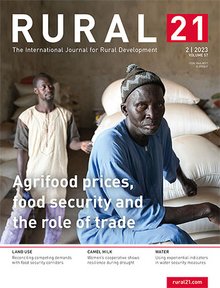Vol. 57 No. 2/2023
Agrifood prices, food security and the role of trade

Following the Russian Army’s invasion of Ukraine in late February 2022, food prices soared up world-wide in next to no time. Not only did the Food Price Index of the UN Food and Agriculture Organization reach an all-time high, fertiliser and energy prices leapt up across the world, too – with the well-documented consequences for food production and supply in many countries, above all in those of the Global South. That the wheat price has now, some 15 months later, returned to its pre-war level – despite the war’s going on and the Ukrainian grain exports having collapsed – shows that the world markets seem to be more resilient than expected.
In this edition, our authors take a look at the complex relations which – alongside the obvious shocks and crises – are behind price formation on the international agrifood markets. They analyse what triggered the major food price spikes in past years and how the food crises then and today differ from each other. Special attention is given to the role of speculation and the growing corporate concentration in the food chain, be it the seeds, farming machinery, agrochemicals or commodity trade sector.
Historically, there has been a pronounced correlation between international food and fertiliser prices. Our authors show what long-term fertilisation strategies could look like – strategies that make farmers and the economies independent of price developments on the international fertiliser markets and above all enhance the yields and labour productivity of smallholders.
Click here if you are interested to subscribe
Download edition 2023/02 Focus: "Agrifood prices, food security and the role of trade
Focus
- Agrifood prices and international trade flows
- Food price inflation, its causes and speculation risks
- AMIS – enhancing food market transparency and policy coordination
- Agricultural prices and food security – a complex relationship
- Strengthening the market linkages of smallholders in the face of global supply shocks
- Long-term fertilisation strategies for blended agricultural sustainability are needed
- Corporate power is growing in the industrial food chain
- Global fertiliser price volatility – approaches to reduce vulnerability among countries in the Global South
- The African Continental Free Trade Area – can the milestone live up to its promise?
- Tapping intra-regional agricultural trade potentials in West Africa



